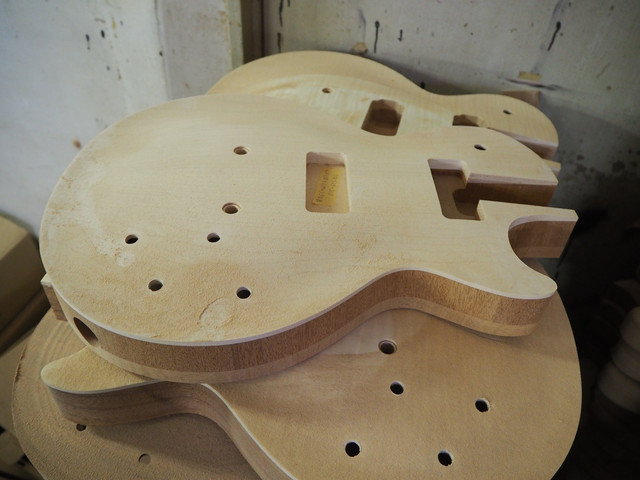Yeah this keeps getting argued about for the same reasons on the Gibby forums as well. The problem is that deriving this from the visuals alone can be pretty misleading I guess - you know how hard it often is to see the glue seam on transparent hog backs, quite often only the lacquer not sinking into the seam as much gives away that there is one after many years. I guess that can be even harder in the (usually a bit rough) PU cavities when the pieces align well, and there is no (or not much) lacquer in the cavities - just 2 pieces of mahogany.
Why this is even an eternal argument is that Gibson never specified that - why would they? Their catalogs are ambiguous and the text (that never changed) allows both interpretations:
 1955 Gibson catalog page
1955 Gibson catalog page
Revisiting the discussions I saw a claim that the shape of the wire channel would be a way to discern that - a round hole indicating a one-piece body. That sounds superficially reasonable considering that a square hole can only be made with a router. But then again, a round channel can also be found in
LPCs with maple top, so that's just the way they insisted to make the Customs for some reason.
To make this even more confusing, all I can see in Tokais (LC or not) is round wire channels, at least the bit in the control cavity? Maybe this is all the Tokai catalog with the confusing text about the awkwardly long drill bit is alluding to, that they're drilling the wire channels the old-fashioned way? What makes this technique difficult is that you can't be sure where exactly the drill is going and and I've read something about locating it with a magnet to make sure you hit both PU cavities and end up in the switch cavity.
Anyway, I'm not saying there can't be one-piece bodies on Gibbys or Tokais. There is just no completely unambiguous, hard evidence that they exist, the nature of the visual evidence is that it's only unambiguous when it's not a one-piece body, and it seems there is no written or at least oral document stating this in a dependable way for either of them?
 i-img742x1200-1700469741bca9nw7.jpg142.7 KB · Views: 0
i-img742x1200-1700469741bca9nw7.jpg142.7 KB · Views: 0 i-img1200x1200-170046974197nxtw7.jpg236.7 KB · Views: 0
i-img1200x1200-170046974197nxtw7.jpg236.7 KB · Views: 0 i-img742x1200-17004697416xkw3p7.jpg93.5 KB · Views: 0
i-img742x1200-17004697416xkw3p7.jpg93.5 KB · Views: 0 i-img742x1200-1700469741wqeoi07.jpg155.7 KB · Views: 1
i-img742x1200-1700469741wqeoi07.jpg155.7 KB · Views: 1 i-img742x1200-1700469741vi1g8e7.jpg96.6 KB · Views: 0
i-img742x1200-1700469741vi1g8e7.jpg96.6 KB · Views: 0 i-img742x1200-1700469741uxjrkl7.jpg158.1 KB · Views: 0
i-img742x1200-1700469741uxjrkl7.jpg158.1 KB · Views: 0 Screen Shot 2024-01-23 at 1.07.31 PM.png645.4 KB · Views: 0
Screen Shot 2024-01-23 at 1.07.31 PM.png645.4 KB · Views: 0 Screen Shot 2024-01-23 at 1.07.44 PM.png436.4 KB · Views: 0
Screen Shot 2024-01-23 at 1.07.44 PM.png436.4 KB · Views: 0 Screen Shot 2024-01-23 at 1.07.58 PM.png890 KB · Views: 0
Screen Shot 2024-01-23 at 1.07.58 PM.png890 KB · Views: 0

















